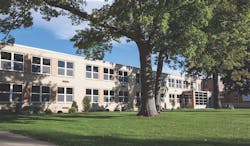Have you ever spent a couple of days at a conference where you never see the light of day? What was your mood? Whether students and teachers are faced with daily situations like that, or the opposite extreme, it is easy to see how windows and daylighting affect comfort, mood, energy, and ultimately effective learning.
Window Wisdom
Throughout the history of school construction, the quality, quantity, size, and placement of windows in schools has varied widely depending on the thought leaders of the time. Many theories and drivers were put forth, but most centered on two general categories—energy and behavior.
For years, it was generally accepted that daylight was better than artificial lighting sources. Not too long ago, school planners decided that all the windows in a classroom—many with entire walls made of glass—were a distraction for students. As educators and designers understand more about how students learn, they have come to recognize that windows provide views and natural light that may help improve outcomes for students, as well as improve the comfort and mood for all.
Building positioning. If contemplating new construction, positioning buildings with an east-west orientation, with windows facing south, is an important strategy to maximize daylighting.
Efficient energy use. In addition to the substantial effect window usage has on lighting, use of windows is a significant factor in heating and cooling a school. Wise product placement by a design team helps control unwanted solar heat gains and losses, lighting levels, and glare.
Selecting windows. Technological advances in windows have heightened their thermal performance. Windows with a lower U-factor (a measure of the rate of heat transfer) or a higher R-value (a measure of the resistance to heat loss) perform better in heating-dominated climates. Windows with lower solar heat gain coefficients (SHGC) perform better in cooling-dominated climates. SHGC is a measure of the amount of solar energy that a glazing material allows to pass.
Updating inefficient windows. Replacing existing windows with high-performance alternatives is an astute decision for an older facility. Daylighting also may be enhanced by using window films to control glare if existing windows have low-E higher-performance glazing.
Beyond Windows
Although windows are critical to proper lighting, comfort, and energy consumption, other variables may make a serious impact.
Find the right finishes. Reflectance values of room surfaces have a notable effect on daylighting. A good rule of thumb is to keep ceiling reflectance at more than 80 percent, walls above 50 percent, and floors close to 20 percent. A well-thought-out paint scheme may be one of the more cost-effective ways to brighten students’ and teachers’ moods.
Fine-tune with photosensors. Photosensors may be used to detect existing prevalent light levels in classrooms, gyms, and common areas, and schools can use the information to adjust lighting, based on the available daylight.
Light from above. Skylights introduce daylight from above, often bringing diffused daylight into a space. Tubular daylight devices, sometimes known as light tubes, are another alternative to bring daylight into a building interior. Interior baffles and overhangs represent worthy considerations, because they provide uniform and effectively diffused lighting.
About the Author
Jody Andres
Senior Project Architect
Jody Andres, AIA LEED AP, is a senior project architect and the K-12 market leader at Hoffman Planning, Design & Construction, Inc. He has worked with more than 50 school districts on educational facilities needs assessment, planning, programming, and design services.
